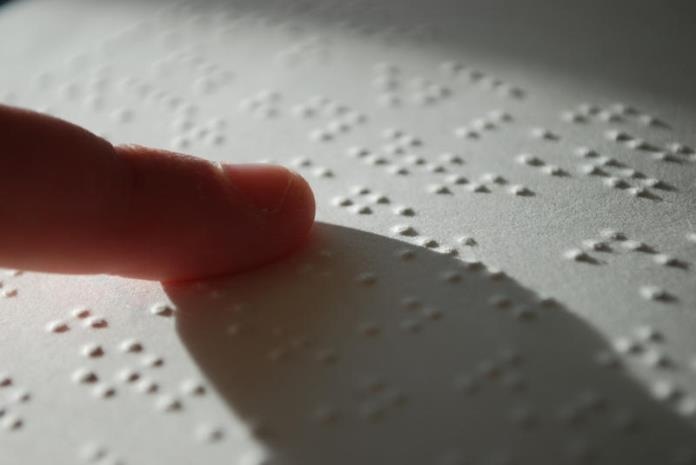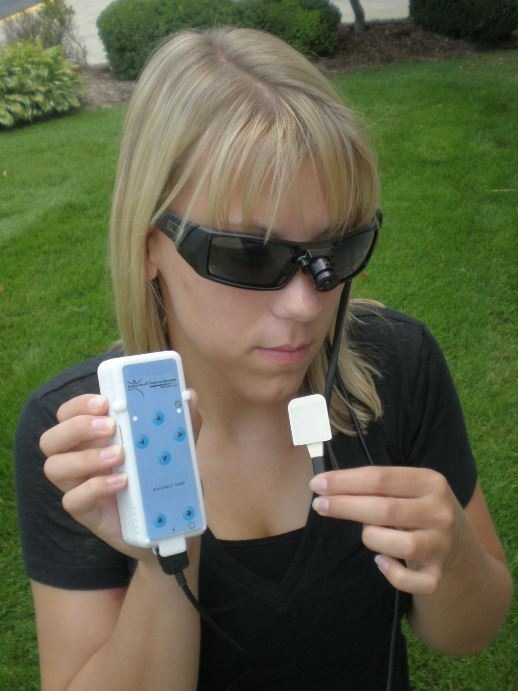From Louis Braille to leading edge technology that helps people see again

I recently visited the theatre in London to see The Braille Legacy, a fascinating theatrical story about Louis Braille – the man who invented braille for the blind.
Louis Braille was born in Coupvray, a town in north central France, on January 4, 1809. At the age of three, he accidentally blinded himself in one eye with a stitching awl taken from his father’s leather workshop. His other eye went blind because of sympathetic ophthalmia, an inflammation of both eyes following trauma to one.
Louis was a young blind boy who wanted the same chance in life as those who see and ended up improving the lives of millions of blind people around the world.
When he was 15, he invented a universal system for reading and writing to be used by people who are blind or visually impaired that now bears his name. He published the first Braille book, Method of Writing Words, Music, and Plain Songs by Means of Dots, for Use by the Blind and Arranged for Them, in 1829, at age 20. A talented musician, he also developed a Braille musical codification.
In Paris in the 19th century, blind people were victims of profound discrimination. Louis Braille, a bright young mind with a mad dream, arrives at the Royal Institute of Blind Youth, searching for the same chance as everyone else: to be free and independent. But he soon discovers that people and things aren’t always what they first seem. By sheer determination and courage, he stumbles upon something revolutionary: a simple idea, a genius invention, a legacy.
Two hundred years ago, Louis Braille changed the world by inventing the tactile system of communication the Braille alphabet, liberating the “People of the Night” and introducing literacy, knowledge and culture to a people who were otherwise trapped. It was their journey into the light.
As an adult, Braille became the first blind apprentice teacher at the New School for the Blind in Paris, France. There, he taught algebra, grammar, music, and geography. He later became the first blind full professor at the school. Braille saved enough money from his teaching position to buy himself a piano so he could practice whenever he wished. Despite his small salary, he also made many personal gifts and loans to his students to help them purchase warm clothing and other necessities. Braille developed tuberculosis in his mid-20s, and for the rest of his life had periods of health interspersed with times of pain and illness. When in good health, he maintained a heavy teaching load and held several jobs playing the organ.
Braille is read by passing one’s fingertips over characters made up of an arrangement of one to six embossed points. The relative positions of these points represent different alphanumeric characters. Braille can be written with a Braillewriter (similar to a typewriter) or by using a pointed stylus to punch dots through paper using an instrument called a Braille slate, which has rows of small cells in it as a guide. Braille has since been adapted to almost every known language and is an essential tool for blind people everywhere.
It’s hard to think about language as being endangered or replaceable. But as our culture and means of communication evolve, certain languages find their utility in decline.
Braille and sign language are in just such a predicament. Technological advancements, such as voice-to-text, digital audio, and the cochlear implant have steadily decreased the demand for these once-revolutionary facilitators for the disabled.
Those who master Braille can reap big benefits. Blind children struggle to learn spelling and grammar without it. Calculations and musical scores are easier to hold at the fingertips than in the head. Even so, more blind people are deciding not to bother.
In the 1950s half of blind American children learned Braille. Now 10% do, and the share globally has fallen so steeply, says Kevin Carey of the London-based Royal National Institute of Blind People, that Braille is on “life support”.
One reason is a shifting market. Since doctors learned 60 years ago that pure oxygen in incubators damaged premature babies’ sight, the number of blind children has fallen in rich countries, where Braille was most used. Changing educational norms mean more attend mainstream schools, where Braille is less likely to be taught. As the population ages, more people are losing their sight late in life, when they are less likely to invest in new skills.
PwC uncovered the compelling link between restoring sight and economic development. It found that for every £1 invested in ending avoidable blindness, there was a £4 economic benefit for a country’s economy. By looking at our key goal through an economic lens, it was demonstrated that ending avoidable blindness has benefits reaching far beyond health alone. If more people in a nation can see, more people can go to school, work, raise children or start businesses. Ending avoidable blindness improves the economy, equality, skills, GDP and development of a nation, while reducing its financial and social burden.
Here are some findings from the research:
• An estimated 32.4 million people are blind around the world
• A further 191 million are visually impaired
• 90% of people who are blind live in developing countries
It’s not just people who are suffering
• Ending avoidable blindness could inject as much as £517 billion into struggling economies over a decade
• Every year, avoidable blindness costs developing countries around £49 billion in lost economic activity
• Ending avoidable blindness in the developing world can be achieved for as little as £2.20 per person, per year
Another is stiffer competition. In the 1960s schools started to use cassette tapes; by the 1980s computers could convert written words to speech, albeit clumsily, or display magnified text. Today’s phone apps read text aloud almost flawlessly.
The advancement with technology now enables reading using a Braille display that sits unobtrusively on a person’s lap and connects to a iPhone via Bluetooth, electronically converting the onscreen text into different combinations of pins. A person reads by gently but firmly running their fingers over the pins with their hand navigating through the phone.
Ebooks could be a game changer if they’re properly designed because it would allow blind people to get access to the same books at the same time at the same price as everyone else. Publishers and manufacturers have to ensure they are designed to be accessible to work with braille displays.
And for partially blind people there are even glasses to improve one’s sight of vision. Blind people can now effectively ‘see’ thanks to a brilliant new British invention – glasses that tell wearers what they are looking at. The glasses, which contain tiny cameras, can identify everything from shop doorways to the contents of a fridge – giving a verbal commentary through a phone app and earpiece. Users can even have printed text read out loud simply by pointing at the words, while those with partial sight can zoom in as they need.

However, for those who own both an iPhone or laptop and a Braille display, having to choose between audio and Braille isn’t necessary. Nowadays, the two go hand in hand – literally. Many of the technologies that convert text to speech also convert it into a form that can be read on a refreshable Braille display, making Braille far more accessible for those who own both devices.
Now technology is offering Braille a shot at reinvention. And whilst Apple are leading the race for Braille technology and innovation, Sumit Dagar, an Indian designer, is working on a smartphone exclusively for the blind. The National Braille Press, an American charity, has developed a prototype Braille tablet. Both emboss Braille by using an alloy that changes shape according to temperature.
In the longer term, built-in cameras could take photos to be etched on screens. And tactile touchscreens being developed by Disney’s researchers could do away with the need for embossing. These use electrical impulses to trick fingers into feeling bumps and ridges. Vibrations create friction; the level of resistance matches the on-screen pattern. Thus rebooted, Braille could live alongside audio technology instead of being replaced by it.
The Technology That Could Make Blind People See Again
Louis Braille created reading for the blind, he was revolutionary in his time improving the lives of millions of blind people around the world – with further investment into technology we now have the ability to improve sight across the world within communities and support people through disability and vision.
As professor Fred Hollows once said:
“To help someone to see was a tremendous feeling and with medical and technological advances, we have greatly increased the ability of eye doctors to give that help.”
""
Articles from Geoff Hudson-Searle
View blogCan a company be successful and competitive in the market and at the same time trusted? · Eric Greit ...

“I want you to understand that the island of Ceylon is for its size the finest island in the world, ...

An interesting subject that seems to be appearing more and more is: ‘what makes each individual uniq ...
Related professionals
You may be interested in these jobs
-

Repairs Supervisor
Found in: Jooble UK O C2 - 5 days ago
Reed London, United KingdomWe are currently recruiting on behalf of a well-established housing provider in the Southeast for an experienced works Supervisor to look after a new contract in the Bracknell area. This will be an initial temp contract whilst they recruit for the role permanently. · Overall Res ...
-
Accounts Assistant
Found in: beBee S2 UK - 2 days ago
Brampton Recruitment Stoke-on-Trent, United Kingdom Full timeThey are looking for an Accounts Assistant to join them for 3-6 months to assist with a backlog of work. · Our client is a prestigious engineering company in Newcastle under Lyme. They are looking for an Accounts Assistant to join them for 3-6 months to assist with a backlog of w ...
-
Recruitment Manager/Senior Manager
Found in: Jooble UK O C2 - 4 days ago
HSBC United KingdomEarly Careers Recruitment Manager EMEA Rate: £275 Per Day PAYE / Inside IR35 · Travel : Krakow – occasional travel · Our client HSBC is currently seeking an Early Careers Recruitment Manager to join their team working from their offices in Sheffield with some travel and overnigh ...


Comments
Geoff Hudson-Searle
6 years ago #2
Glad you enjoyed the buzz Jerry! :-)
Jerry Fletcher
6 years ago #1